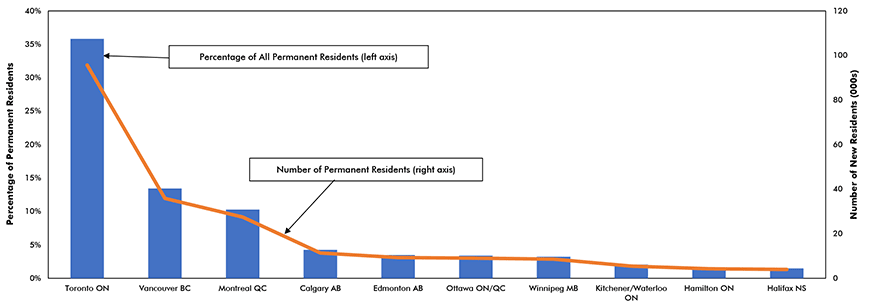Despite the persisting negative impacts of COVID-driven travel restrictions, the volume of individuals seeking to become permanent residents of Canada has increased by 87% year to date to a record 267,000 from 143,000 in 2020. Speaking to a news conference in mid-November, before much attention was being paid to the Omicron COVID variant, Sean Fraser, Canada’s immigration minister, said the government was “on track to exceed its goal of offering permanent residency to over 400,000 this year.”
Also, Mr. Fraser is prepared to increase immigration targets for next year, currently set at 411,000.�� While the recent onset of Omicron may temporarily restrict the inflow of permanent residents, the impact of this variant on those who have recently entered the country should be muted by the high levels of vaccine penetration in the country’s 10 largest Census metro areas (CMAs). Collectively, they have admitted 80% of the permanent residents to Canada over the past five years.��
Toronto admits one of every three permanent residents
Although, according to the Royal Bank’s housing affordability measure, it is the second least affordable CMA in the country (after Vancouver), Toronto continues to attract the largest percentage of permanent residents admitted to Canada. Over the past five years, the share of permanent residents choosing TO has steadily increased from 27.5% in 2016 to 36% year to date in 2021.
While Toronto continues to attract the largest proportion of newcomers to Canada, there is evidence the CMA’s high house prices are prompting an increasing share of newcomers to locate in more affordable locations within the GTA’s commuter-shed. Compared to the first nine months of pre-pandemic 2019, the number of permanent residents arriving in the Toronto CMA has risen by +3.1% this year while, at the same time, the number of permanent residents that located in one of the eight CMAs adjacent to Toronto has risen by +43%.
Consistent with this evidence of population shift is the fact that over the past five years the outflow of individuals from Toronto to other parts of the province has averaged 45,000, more than double the number exiting the CMA during the previous five years.
Vancouver to see unprecedented inflow in 2021
Given the “pull” of Vancouver’s recent strong pattern of job creation, noted in Snapshot #22, together with the “push” of mainland China’s increasing intervention in Hong Kong, it is not surprising that the CMA has attracted an unprecedented year-to-date inflow of permanent residents.�� Over the past nine months, the city has welcomed 35,000 permanent residents, a 17% increase over the pre-pandemic high of 30,400 reached in 2019. As a result of this strong rise in permanent residents, Vancouver now attracts the second largest percentage of permanent residents among Canadian cities, up from its third-place ranking in 2018.
After partly closing the door in 2019, Quebec opens it again
After attracting the second highest share of permanent residents between 2009 and 2018, the percentage of the country’s permanent residents arriving in Montreal has slipped behind Vancouver over the past three years. Following Quebec Premier Francois Legault’s promise to reduce the number of immigrants to Quebec by 20%, the number of permanent immigrants to the province dropped by -20.1% in 2019 and, exacerbated by the onset of COVID-19, retreated by a further -39% in 2020.
Subsequently, the restrictions on immigration severely restricted the inflow of skilled workers into the province, where the job vacancy rate hit a record high of 7.3% in September of this year.
Montreal has borne the brunt of the drop in net migration. Year-to-date, the inflow of net permanent residents to Montreal is down by -6,700, compared to a drop of -5,700 for the entire province. Recognizing that the province as a whole and Montreal, especially, were suffering an acute shortage of labour, Premier Legault announced on November 30th a $3.9 billion plan to attract 170,000 more workers in certain priority sectors: information technology, engineering, and construction. It’s worth noting that over the past 12 months, while total employment in Quebec is up by +3.4%, construction hiring is down by -5.6%.
The impact of stronger hiring fueled by rising energy prices also appears to be giving a boost to the inflow of permanent residents in Calgary, Edmonton, and Regina. Moreover, this trend will likely strengthen due to further gains in energy prices driven by stronger global economic growth.
John Clinkard has over 35 years’ experience as an economist in international, national and regional research and analysis with leading financial institutions and media outlets in Canada.
Top ten recipients of permanent residents in Canada – number of residents and percentage of total

Chart: ����ӰԺ — CanaData.







Ont and Vancouver do not have enough housing for those already here. This driven up rent one percent of people in Ont are homeless. Many truck drivers living in homeless shelters when they get hurt.